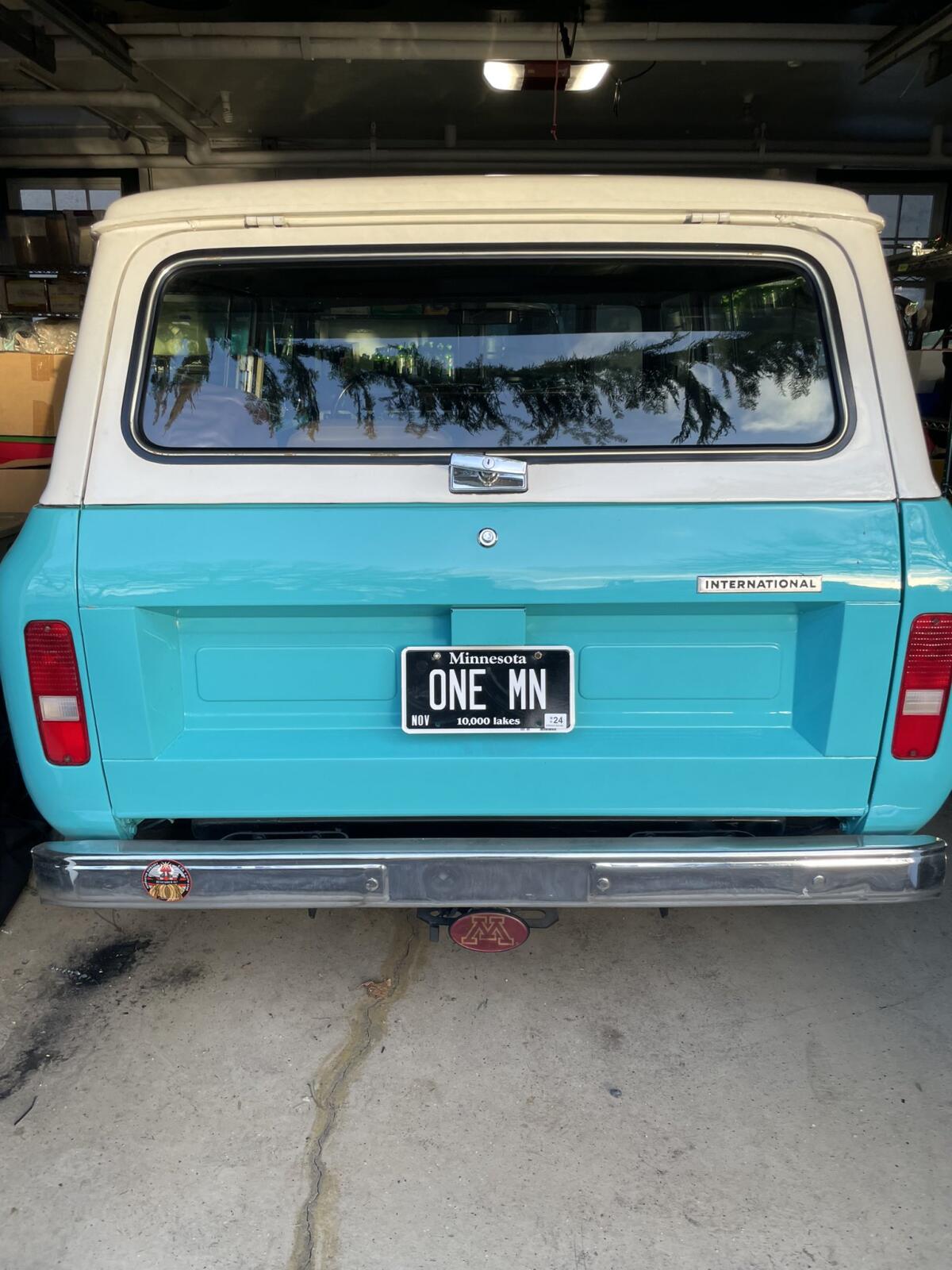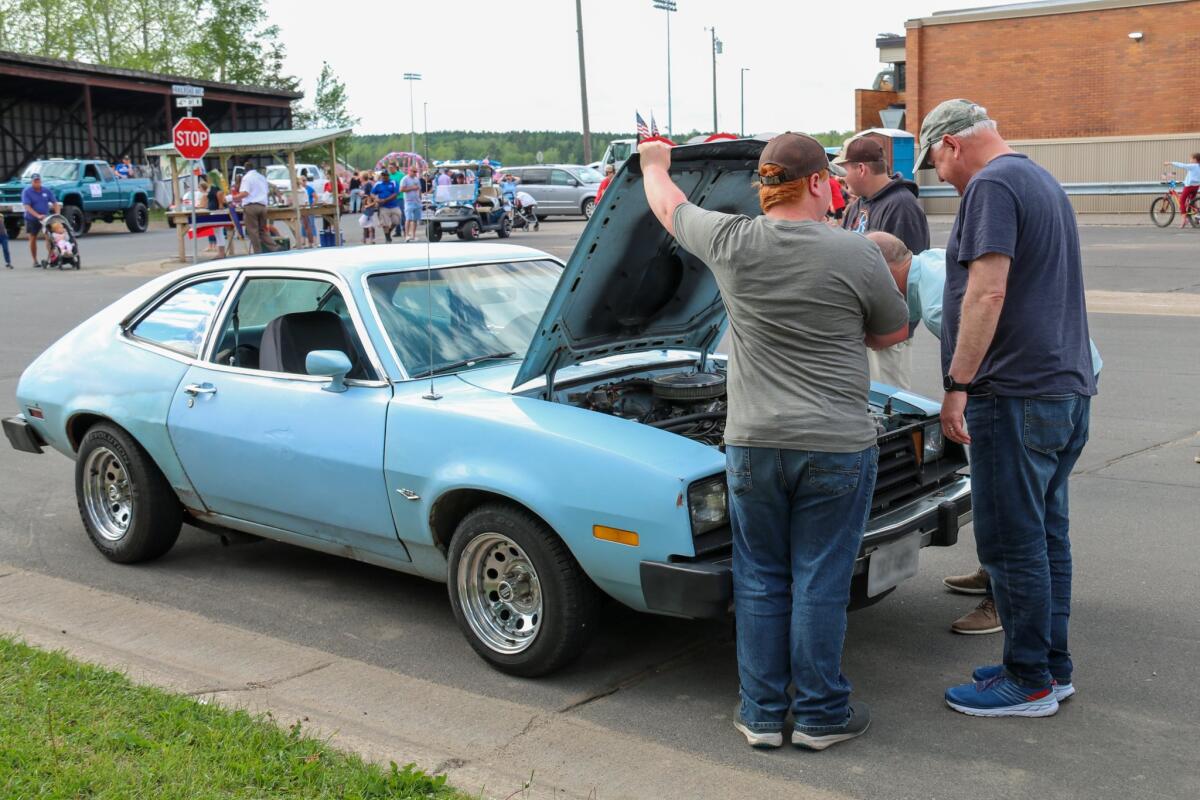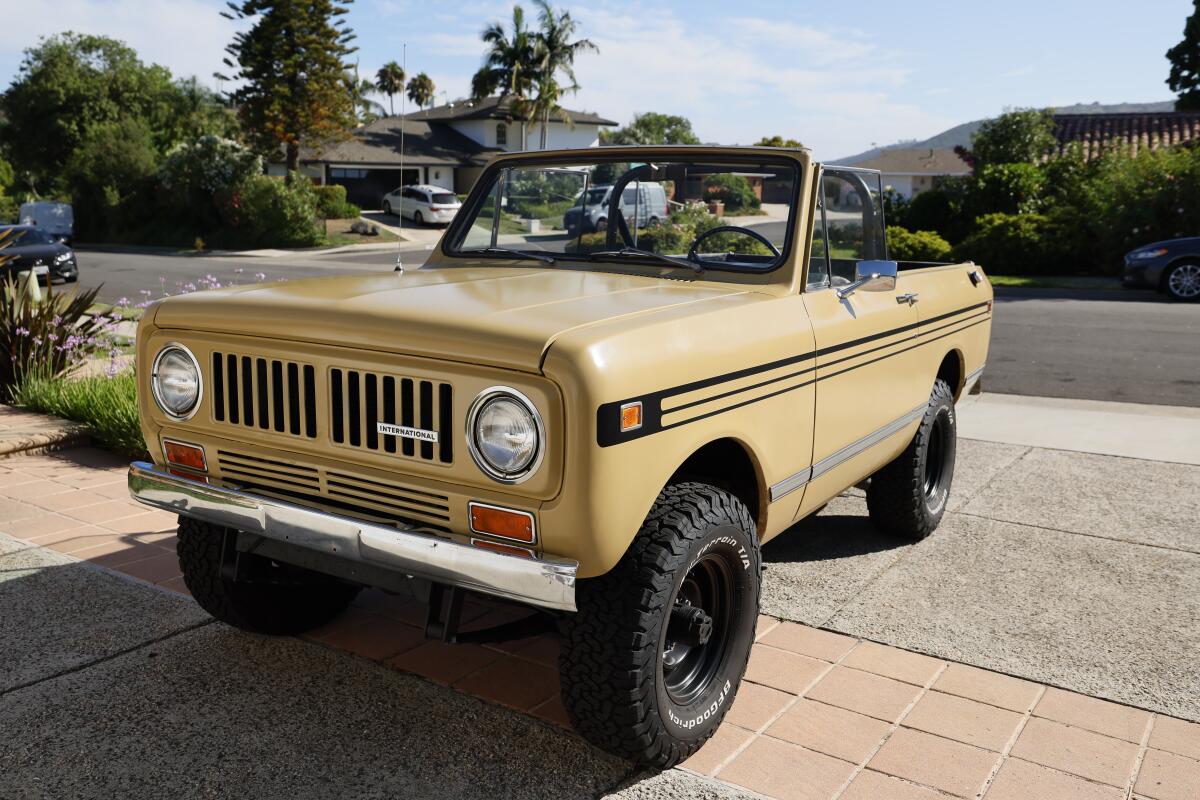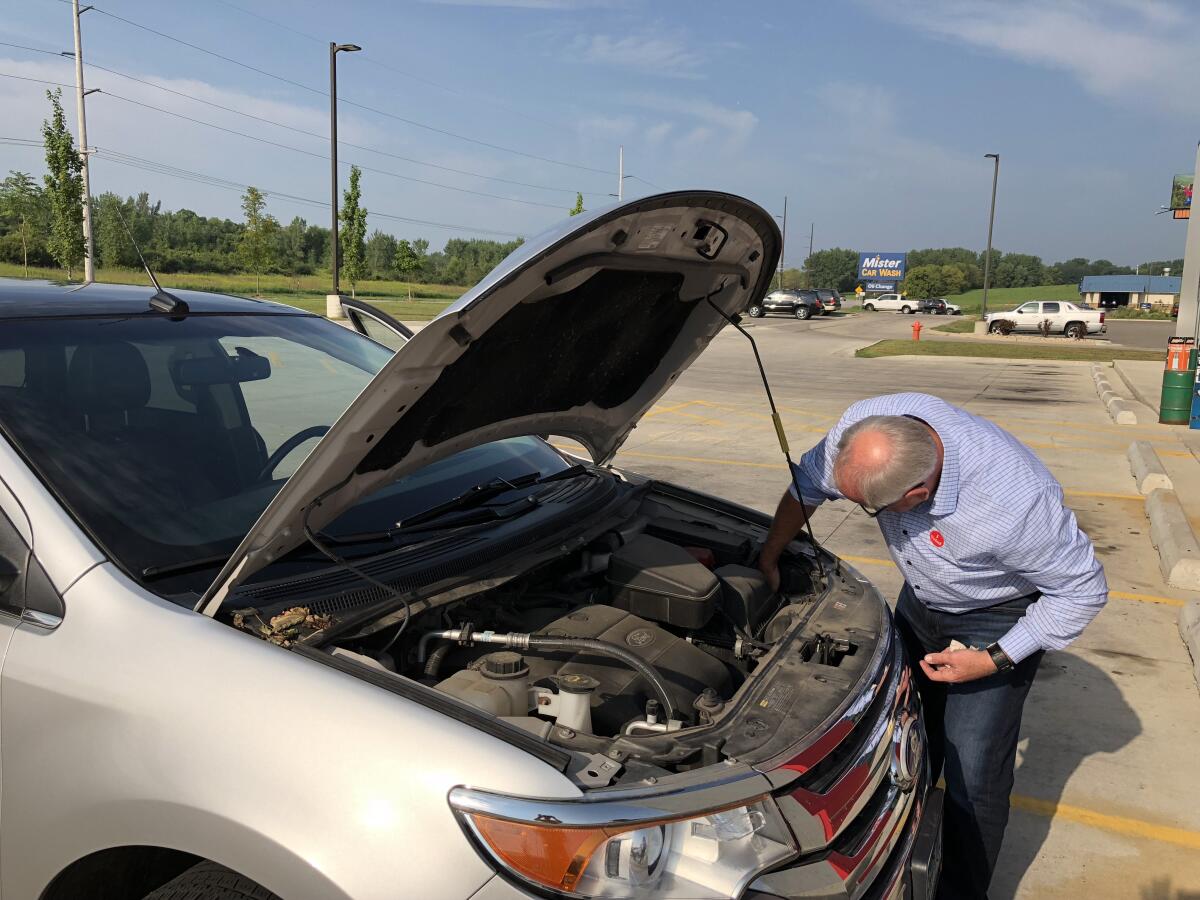Tim Walz is a big car guy. Will it help him with voters? - Los Angeles Times (original) (raw)
In 2007, when Tim Walz was a freshman congressman, he told a reporter that his dream car was a 1973 Chevrolet Camaro, noting, “I’m kind of a muscle-car guy.” What he was actually driving was a more staid choice: a Dodge minivan.
But a year after that interview with the Hill, the self-professed car guy bought a vehicle that is now making headlines and has come to define the vice presidential candidate’s I’m-from-a-small-town, Minnesota-dad vibe: a 1979 International Harvester Scout II.
The choice impresses people like Brandon Ray, a 48-year-old fellow Scout II owner from Phoenix. As Ray tells it, he’d just gone through a divorce 15 years ago when a “bad-ass” yellow Scout II caught his eye. The SUV bore two decals: One said, “Face your fears,” the other, “Live your dream.” He bought the Scout.
“It did what it said it was gonna do,” Ray said. “I faced my fears and lived some of my dreams in that truck.”
News that Walz owns a 1979 Scout II came as a surprise to Ray. “I just don’t picture a blue guy driving a f— Scout,” he said, referencing Walz’s Democratic affiliation.

Walz’s International Harvester Scout II has a license plate referencing his “One Minnesota” political slogan.
(Courtesy of Tim Walz)
Cars and politics have long mixed. With exhortations to “buy American,” presidents have almost always favored rides from U.S. automakers. That includes President Biden, who cherishes his 1967 Chevrolet Corvette Stingray.
Amid Walz’s whirlwind journey to the national political stage, his car credentials have become part of his story. Notably, a 2018 video of Walz admonishing Ford over a low-quality headlight harness has resurfaced to the delight of gearheads.
The teacher-turned-Minnesota governor wrenches on cars and goes to classic auto shows, too. But the most obvious part of his pistons-and-pushrods persona is his Scout.
For years, Walz, 60, has taken to social media to share photographs of his Scout, which is painted an arresting glacier blue and sports a license plate that reads “ONE MN,” an apparent reference to his “One Minnesota” political slogan. Of the many American classics still roaming the roads, the Scout is one imbued with particular meaning.

Minnesotans talk vintage cars with the governor, right, over the engine of a 1978 Ford Pinto in 2022.
(Courtesy of Tim Walz)
The Scout was produced in Fort Wayne, Ind., by International Harvester from 1960 to 1980 in multiple guises spread across two generations, known as I and II. It is among the quirkiest of the vintage SUVs that have become popular in recent years. The Scout wasn’t made by a familiar automotive brand: International Harvester was a Chicago-based farm equipment company that shut down about 40 years ago.
That has made the Scout less recognizable to the Instagram set — and more appealing to enthusiasts looking for a deal at a time when vintage Ford Broncos often sell for more than $100,000. The Scout, said Randy Nonnenberg, cofounder of the automotive auction platform Bring a Trailer, has “always been an underdog.”
With its boxy body, chrome grille, round headlights and removable or soft top, it is practical, charming and not too flashy. “Scouts are very Midwest, which is very on-brand” for Walz, said Nonnenberg, whose company has auctioned 285 Scout IIs at an average price of about $38,000. “It’s kind of like the vehicle version of him.”
Some other Scout owners agree.

This International Harvester Scout II was restored by Gary Brown, an Orange County resident who is impressed that Walz maintains one of his own.
(Allen J. Schaben / Los Angeles Times)
“Anyone who wants to maintain and keep a ’79 Scout is not your average person,” said Gary Brown, an Orange County software engineer who has restored and sold about 10 Scouts over three decades. “It takes someone with a retro or somewhat older mindset ... [who] knows how to tinker.”
“I like guys like that — guys who can fix things,” he said.
As for Ray, who is selling another Scout — a rare 1978 version priced at $59,999 — he didn’t want to talk politics, which he called “a tough topic.”
But, in a nod to the unifying power of cars, Ray imagined a trip he and Walz might take into the wilds of the Southwest: “Maybe he and I can go out in the dunes one of these days?”
No ‘garage queen’
Walz appears to have a genuine passion for cars, but he also seems to possess a finely calibrated understanding of how his actions may play with voters, said Matt Hardigree, publisher of the Autopian, which has written about the politician.
Just take the governor’s social media posts featuring his Scout and another Scout — his dog. That, Hardigree said, “is an unhateable image.”
“It is Norman Rockwell transported 50 years into the future,” he said.

Walz, working on a car in 2018, has demonstrated a fix-it ethos that could resonate with some voters.
(Courtesy of Tim Walz)
Then there’s Minnesota’s right-to-repair law, one of several such measures passed by states in recent years. Signed by Walz in 2023 and called the Digital Fair Repair Act, it directs makers of electronics and other items to give consumers access to information and parts so that they can repair their own devices.
Although the law doesn’t cover cars, Hardigree said it shows that Walz subscribes to a fix-it ethos that many vintage car owners can appreciate.
In the case of the Scout, maintaining one is no small feat, because parts are hard to come by. Still, Hardigree, who reviewed images of Walz’s ride, approved of the politician’s upkeep: “It’s clean, but it’s clearly driven. It’s not a garage queen.”
Being a motorhead is such a part of Walz’s political persona that it became the subject of a joke during this month’s Democratic National Convention. TV producer Ben Wexler, whose credits include “Arrested Development,” posted on X, “If Tim Walz walks out onstage wiping his hands on a greasy rag because he just fixed the transmission on the campaign bus, we win all 50 states.”
Scouting for votes
When Ray expressed surprise over Walz’s ownership of a 4x4, he was tapping into a stereotype: Trucks are for Republicans. It’s a notion that former President Trump has leaned into, singing the praises of beefy American rides, even saying in 2019, “I love trucks of all types.”
“Even when I was a little boy at 4 years old my mother would say, ‘You love trucks,’” Trump continued. “I do. I always loved trucks.”
Hardigree, a former Texas political consultant, said that a truck has long been a requirement to get elected in that state.
“The sense [in Texas] was you couldn’t get elected as a Democrat or a Republican if you didn’t own a pickup truck,” he said. “But the Republicans never had to prove they drove a truck, and the Democrats always did.”
Nonnenberg said that Walz’s Scout — and his ability to work on it — could help him find common ground with voters.
“It shows his connection to reality,” said Nonnenberg, who spoke with The Times from the wheel of his Rivian R1S electric SUV, whose styling calls to mind the Scout. “This guy is not out of touch with normal Americans.”
Elana Scherr, a senior editor at Car and Driver, took it a step further: “Having a hobby and being genuinely into it is charming.”
Could Walz’s ownership of a Scout convince some Republican car cognoscenti to vote for Kamala Harris? Nonnenberg is doubtful, believing it’s little more than an “interesting contextual addition” that would hardly change minds. It could, however, raise the profile of a new breed of Scout at an auspicious moment.
In a twist, the Scout is coming back, with a new model expected by 2026. The 4x4 is being revived by Volkswagen, which acquired its trademark in 2021.
The new car will feature styling that harks back to the original. But it won’t be like the Scout that Walz drives in one important way, adopting technology whose proponents Trump has urged to “ROT IN HELL.”
It’ll be electric.